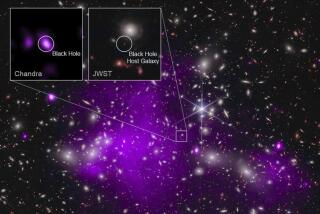New NASA X-ray telescope to bring black holes into sharp focus
NASA will be launching a new telescope expected to bring black holes and supernovae into unprecedented focus, mission scientists announced Wednesday.
The Nuclear Spectroscopic Telescope Array, a mission to hunt for black holes, is scheduled to launch no sooner than June 13 from the Kwajalein Atoll in the Marshall Islands, located north of the equator. It will look at some of the most mysterious phenomena in the universe, from the high-speed particle jets that blast from black holes to the remnants of exploded stars known as supernovae. It will even shed light on mysteries closer to home, such as what powers the sun’s corona, a ghostly glow of charged particles that heats up to a million degrees.
“NuSTAR will open a whole new window on the universe by being the very first telescope to focus high-energy X-rays,” said Fiona Harrison, principal investigator at Caltech in Pasadena. “As such it will make images that are 10 times crisper and 100 times more sensitive than any telescope that is operated in this region of the spectrum.”
Previous high-energy X-ray telescopes that could detect above 15 keV haven’t been able to focus in on their targets because they relied on what are called “coded apertures.” Basically, because high-energy X-rays are notoriously difficult to focus, such telescopes would instead have patterned screens to block some of the light — and would essentially use the resulting pattern of cast shadows to reconstruct the original images.
Needless to say, the resulting images of, say, black holes in the sky, have been fuzzy at best — rather like dim headlights seen through a rain-blurred window on a dark, foggy night. But by being able to reflect and redirect X-ray light, NuSTAR could bring the X-rayed sky into pinpoint-sharp focus.
The telescope works by having highly reflective, double-coated mirrors focus light onto detectors some 10 meters away. The X-rays will reflect only if they bounce off the mirrors at a grazing angle — almost parallel to the X-rays themselves. The mirrors and detectors are connected by a 10-meter-long bridge that will unfold once the telescope is in orbit around Earth.
Other space telescopes like the Hubble Space Telescope, Swift and the Chandra X-Ray Observatory have canvassed the night skies but not at such high-energy wavelengths of the electromagnetic spectrum: NuSTAR will be able to detect X-rays with energies as high as 79 kiloelectronvolts. Previous focusing-telescope missions, according to the NuSTAR site, were sensitive only up to about 15 keV.
Along with canvassing the black holes in the area, the researchers are betting that they’ll be able to catch a supernova in the act of exploding, because in a galaxy like the Milky Way, they typically go off once every 30 years. “
It’s been about a hundred years since we know one went off in our galaxy,” said Daniel Stern, NuSTAR project scientist at NASA’s Jet Propulsion Laboratory in Pasadena. “So we’re really crossing our fingers that, over the next couple years, while NuSTAR is up in orbit, a new supernova will go off in our galaxy.”
Follow me on Twitter @aminawrite.







